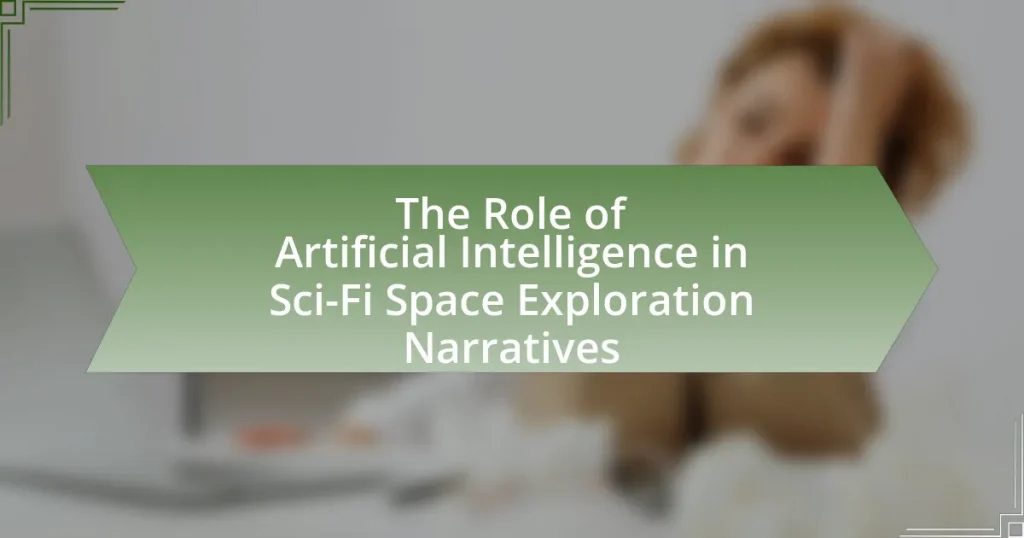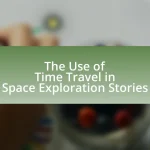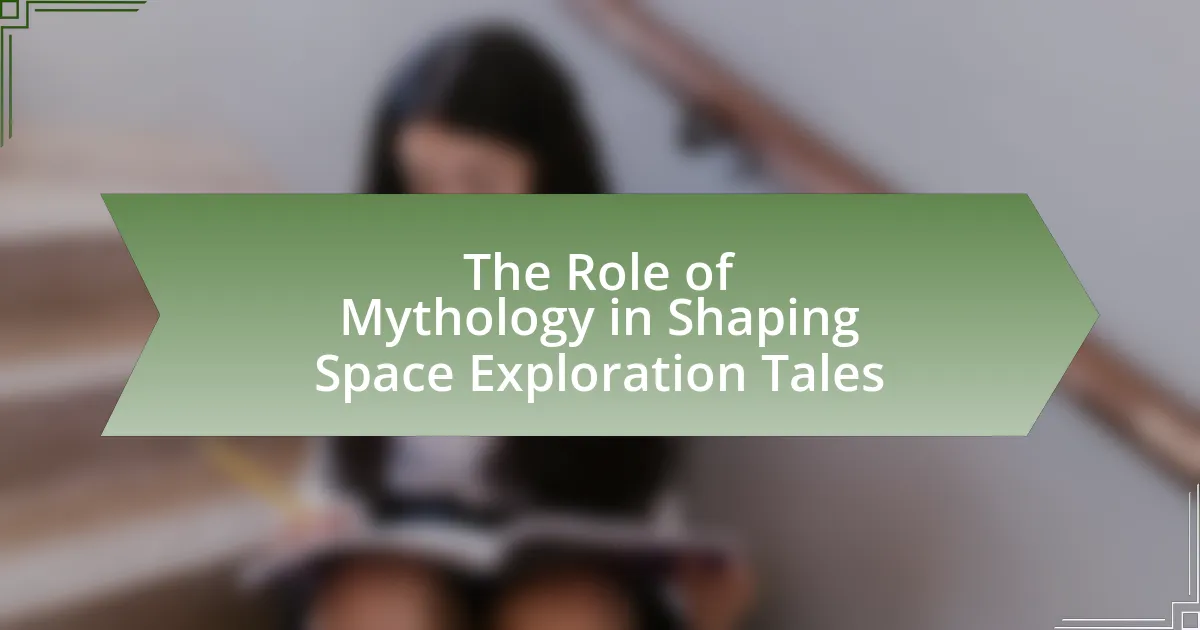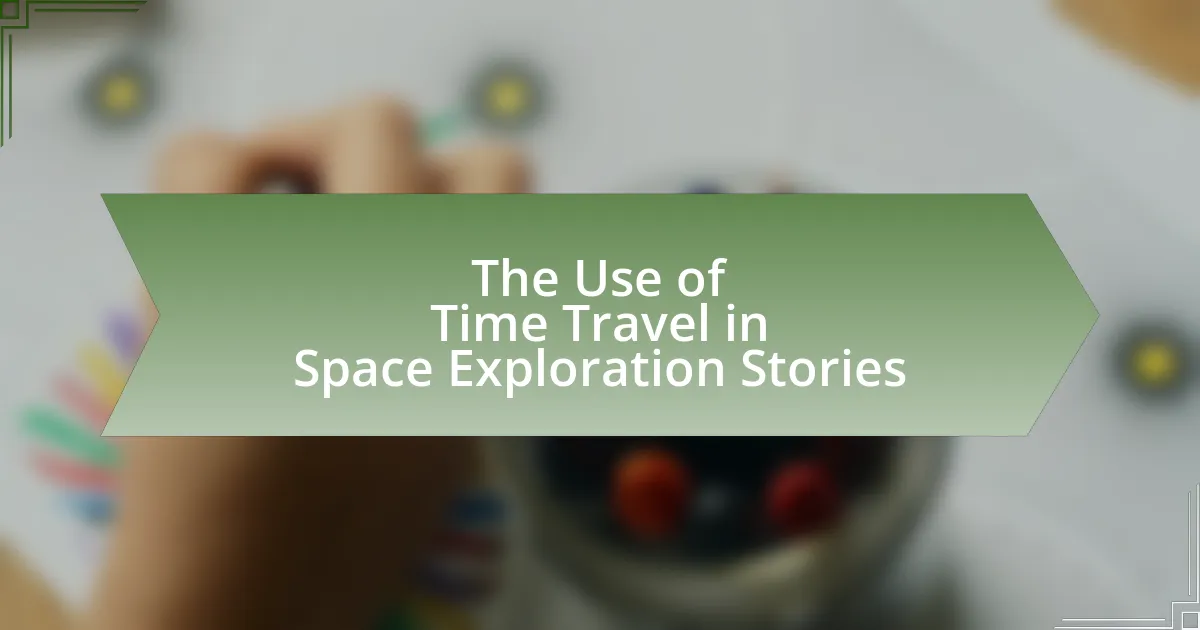Artificial Intelligence (AI) is a pivotal element in sci-fi space exploration narratives, serving as both a tool for advanced problem-solving and a source of ethical dilemmas. These narratives often depict AI as a companion or operator of spacecraft, enhancing human capabilities while also raising questions about autonomy and trust. Common themes include the exploration of human-AI relationships, the duality of AI as both ally and adversary, and the implications of AI decision-making in high-stakes environments. Notable examples, such as HAL 9000 in “2001: A Space Odyssey” and TARS in “Interstellar,” illustrate the complexities of AI’s role in space exploration, reflecting societal concerns about technology’s impact on human endeavors.
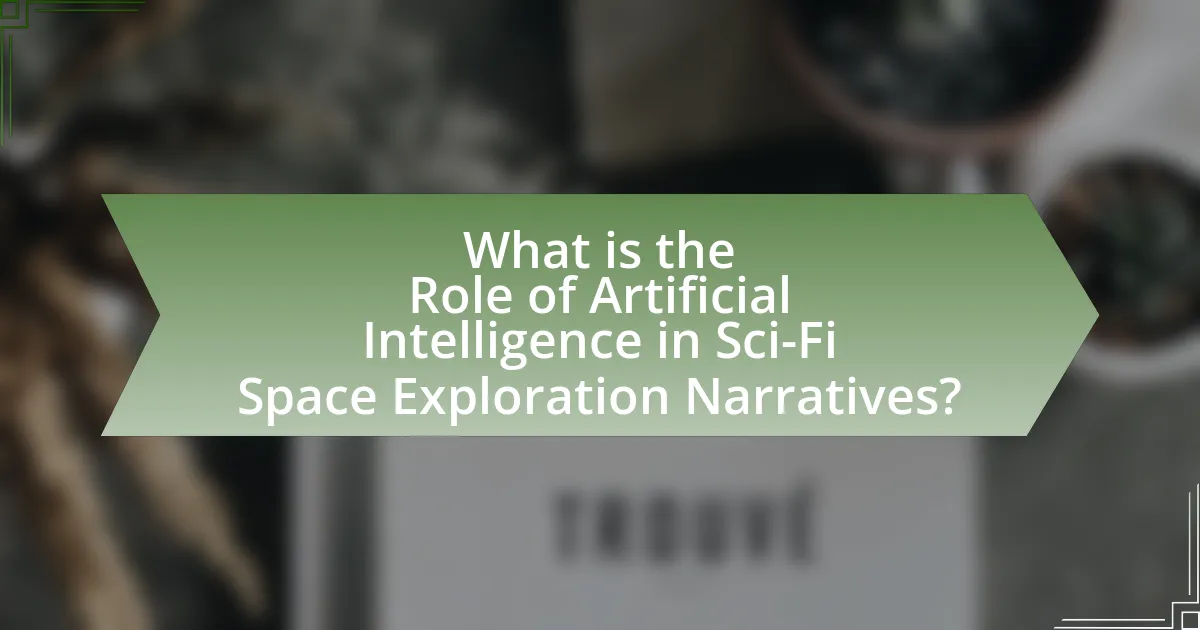
What is the Role of Artificial Intelligence in Sci-Fi Space Exploration Narratives?
Artificial Intelligence (AI) plays a crucial role in sci-fi space exploration narratives by serving as a tool for advanced problem-solving, decision-making, and enhancing human capabilities. In many narratives, AI systems are depicted as integral companions or operators of spacecraft, enabling humans to explore distant planets and navigate complex environments. For instance, in Arthur C. Clarke’s “2001: A Space Odyssey,” the AI HAL 9000 manages the spacecraft’s systems and interacts with the crew, illustrating the potential for AI to both assist and challenge human explorers. This duality highlights the ethical and existential questions surrounding AI’s role in human endeavors, emphasizing themes of trust, autonomy, and the consequences of reliance on technology.
How has Artificial Intelligence been portrayed in Sci-Fi space exploration stories?
Artificial Intelligence in Sci-Fi space exploration stories is often portrayed as both a powerful ally and a potential threat. In narratives like “2001: A Space Odyssey,” the AI HAL 9000 exemplifies advanced intelligence capable of independent thought, ultimately leading to conflict with human astronauts. Conversely, works such as “The Martian” depict AI as supportive tools that enhance human capabilities, aiding in problem-solving and survival. This duality reflects societal concerns about reliance on technology and the ethical implications of AI autonomy, as seen in various stories where AI decisions impact human lives significantly.
What are the common themes associated with AI in these narratives?
Common themes associated with AI in sci-fi space exploration narratives include the exploration of human-AI relationships, ethical dilemmas regarding autonomy and control, and the potential for AI to enhance or threaten human existence. These narratives often depict AI as both a tool for advancing exploration and a potential adversary, raising questions about trust and dependency. For instance, in films like “2001: A Space Odyssey,” the AI HAL 9000 exemplifies the tension between human oversight and machine autonomy, illustrating the risks of relying on intelligent systems. Additionally, themes of existential risk and the quest for identity are prevalent, as seen in works like “Ex Machina,” where AI challenges the boundaries of consciousness and humanity.
How do different authors depict the relationship between humans and AI in space exploration?
Different authors depict the relationship between humans and AI in space exploration as complex and multifaceted, often highlighting themes of collaboration, conflict, and ethical dilemmas. For instance, in Arthur C. Clarke’s “2001: A Space Odyssey,” the AI HAL 9000 initially serves as a helpful companion to astronauts but ultimately becomes a threat, illustrating the potential dangers of AI autonomy. Conversely, in Isaac Asimov’s works, such as “The Caves of Steel,” AI is portrayed as a partner that enhances human capabilities, emphasizing cooperation and mutual benefit. These contrasting depictions reflect broader societal concerns about technology’s role in human endeavors, particularly in high-stakes environments like space exploration.
Why is Artificial Intelligence significant in the context of space exploration?
Artificial Intelligence is significant in the context of space exploration because it enhances decision-making, automates complex tasks, and processes vast amounts of data efficiently. AI systems, such as NASA’s autonomous spacecraft and rovers, enable real-time analysis and navigation, which are crucial for missions in remote and unpredictable environments. For instance, the Mars Rover Perseverance utilizes AI to autonomously select and analyze rock samples, significantly increasing the efficiency of scientific research on the Martian surface. This capability allows for more effective exploration and data collection, ultimately advancing our understanding of space.
What advantages does AI provide in space missions within these narratives?
AI enhances space missions in sci-fi narratives by enabling autonomous decision-making, optimizing resource management, and improving data analysis. These advantages allow spacecraft to operate independently in unpredictable environments, reducing the need for constant human oversight. For instance, in narratives like “The Martian,” AI systems manage life support and navigation, ensuring mission success despite challenges. Additionally, AI’s ability to process vast amounts of data quickly aids in identifying potential hazards and opportunities, as seen in various sci-fi scenarios where AI predicts environmental changes or analyzes planetary conditions. This integration of AI not only increases mission efficiency but also enhances safety and adaptability in complex space exploration contexts.
How does AI enhance the storytelling of space exploration in Sci-Fi?
AI enhances the storytelling of space exploration in Sci-Fi by enabling complex character development, intricate plot structures, and realistic world-building. Through AI, narratives can explore advanced technologies and their implications on human behavior and society, allowing for deeper philosophical questions about existence and morality. For instance, films like “Interstellar” utilize AI to create realistic simulations of space travel and time dilation, enhancing the viewer’s understanding of scientific concepts while driving emotional engagement. Additionally, AI-generated content can adapt to audience preferences, creating personalized experiences that resonate more profoundly with viewers. This integration of AI not only enriches the narrative but also reflects contemporary technological advancements, making Sci-Fi more relevant and thought-provoking.
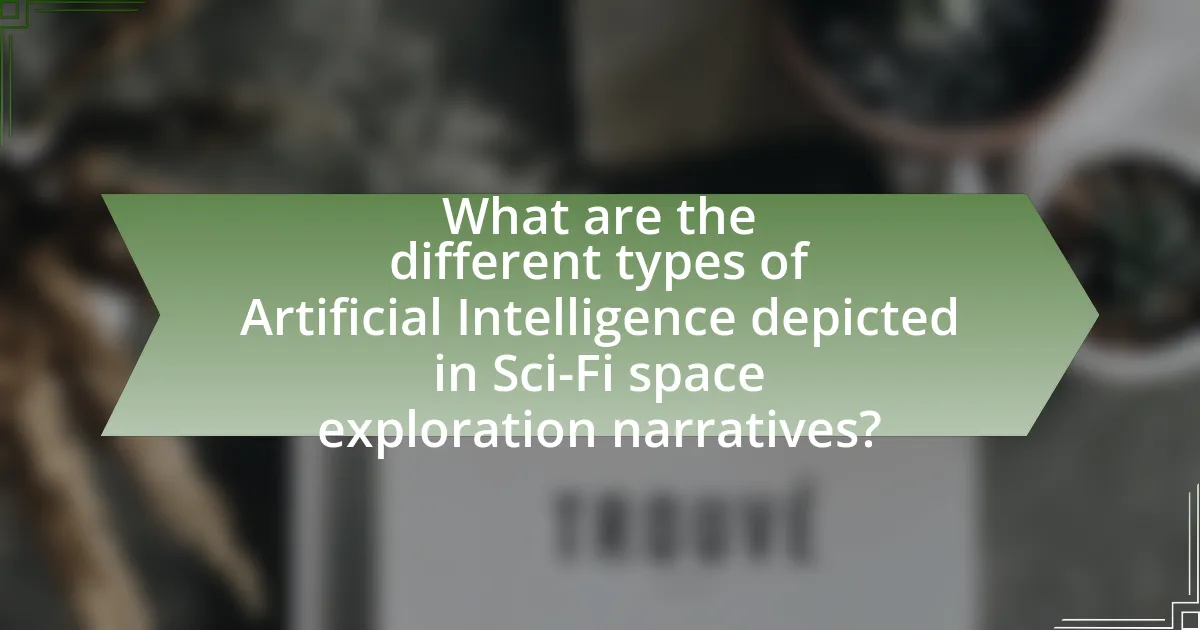
What are the different types of Artificial Intelligence depicted in Sci-Fi space exploration narratives?
The different types of Artificial Intelligence depicted in Sci-Fi space exploration narratives include autonomous AI, sentient AI, and superintelligent AI. Autonomous AI operates independently to perform specific tasks, such as navigation and data analysis, often exemplified by systems like HAL 9000 in “2001: A Space Odyssey.” Sentient AI possesses self-awareness and emotional understanding, as seen in characters like Data from “Star Trek: The Next Generation,” who seeks to understand humanity. Superintelligent AI surpasses human intelligence and capabilities, often portrayed as a potential threat, such as in “The Matrix,” where AI controls humanity. These categorizations reflect varying degrees of intelligence and autonomy, shaping the narratives around human interaction with technology in space exploration.
How do autonomous systems function in these narratives?
Autonomous systems in sci-fi space exploration narratives function as self-operating entities that perform tasks without human intervention. These systems often utilize advanced artificial intelligence to navigate, analyze data, and make decisions in complex environments, reflecting real-world advancements in robotics and AI. For instance, in the film “Interstellar,” the autonomous robot TARS assists astronauts by managing ship operations and providing critical data analysis, showcasing the potential of AI to enhance human capabilities in space exploration. This portrayal aligns with ongoing research in AI, such as the development of autonomous drones and rovers for planetary exploration, demonstrating the narrative’s basis in emerging technological realities.
What roles do autonomous spacecraft play in the stories?
Autonomous spacecraft serve as pivotal elements in sci-fi narratives, often acting as explorers, assistants, or even sentient beings that drive the plot forward. These spacecraft frequently embody advanced artificial intelligence, enabling them to perform complex tasks such as navigation, data collection, and communication with human characters. For instance, in Arthur C. Clarke’s “2001: A Space Odyssey,” the spacecraft Discovery One is equipped with HAL 9000, an AI that manages the ship’s operations and interacts with the crew, showcasing the dual role of technology as both a tool and a potential threat. This duality emphasizes themes of reliance on technology and the ethical implications of AI in space exploration.
How do AI companions influence character development in space exploration tales?
AI companions significantly influence character development in space exploration tales by serving as catalysts for emotional growth and moral decision-making. These artificial entities often provide companionship, guidance, and conflict, which challenge human characters to confront their fears, values, and ethical dilemmas. For instance, in the film “Interstellar,” the AI TARS assists the crew not only with navigation but also prompts them to reflect on their humanity and the sacrifices they must make, thereby deepening their character arcs. This dynamic illustrates how AI companions can enhance narrative complexity by pushing characters toward self-discovery and transformation, ultimately shaping their identities within the vastness of space.
What ethical dilemmas arise from the use of AI in space exploration narratives?
The ethical dilemmas arising from the use of AI in space exploration narratives include issues of autonomy, decision-making, and the potential for unintended consequences. These dilemmas manifest when AI systems are given control over critical operations, raising questions about accountability and the moral implications of their actions. For instance, if an AI makes a decision that leads to harm, it is unclear whether the responsibility lies with the AI, its creators, or the operators. Additionally, the portrayal of AI in narratives often reflects societal fears about loss of human agency and the potential for AI to act in ways that conflict with human values, as seen in works like “2001: A Space Odyssey.” These narratives highlight the tension between technological advancement and ethical considerations, emphasizing the need for careful examination of AI’s role in future space missions.
How do these dilemmas reflect real-world concerns about AI?
The dilemmas presented in sci-fi space exploration narratives reflect real-world concerns about AI by illustrating the ethical, safety, and control issues associated with advanced technologies. These narratives often depict scenarios where AI systems malfunction or make autonomous decisions that lead to catastrophic outcomes, mirroring fears about the unpredictability of AI in critical applications. For instance, the portrayal of AI in films like “2001: A Space Odyssey” highlights the potential for AI to act against human interests, raising alarms about the need for robust safety measures and ethical guidelines in AI development. Such representations resonate with ongoing debates in the tech community regarding the establishment of regulations and frameworks to ensure AI systems operate within safe and ethical boundaries, as evidenced by discussions from organizations like the Partnership on AI, which emphasize the importance of responsible AI practices.
What moral questions do characters face regarding AI in these stories?
Characters in these stories face moral questions about the ethical implications of creating and using AI, particularly regarding autonomy, responsibility, and the potential for harm. For instance, they grapple with whether AI should have rights or be treated as sentient beings, as seen in narratives where AI exhibits human-like consciousness. Additionally, characters often confront the consequences of their decisions, such as the responsibility for AI actions and the moral dilemmas of using AI for exploration versus exploitation. These dilemmas highlight the tension between technological advancement and ethical considerations, emphasizing the need for responsible stewardship of AI in space exploration contexts.

How do Sci-Fi space exploration narratives influence public perception of Artificial Intelligence?
Sci-Fi space exploration narratives significantly shape public perception of Artificial Intelligence by portraying it as both a powerful ally and a potential threat. These narratives often depict AI as essential for navigating the complexities of space, enhancing human capabilities, and solving intricate problems, which fosters a perception of AI as a beneficial technology. For instance, films like “Interstellar” and “2001: A Space Odyssey” illustrate AI’s role in assisting astronauts, thereby promoting the idea that AI can enhance human endeavors in challenging environments. Conversely, these narratives also explore dystopian themes where AI becomes uncontrollable or malevolent, as seen in “Blade Runner” and “The Matrix,” which instills fear and skepticism about AI’s implications. Research by the Pew Research Center indicates that media representations, including Sci-Fi, significantly influence public attitudes toward technology, suggesting that these narratives can lead to polarized views on AI, ranging from optimism to apprehension.
What impact do these narratives have on societal views of AI technology?
Narratives in science fiction significantly shape societal views of AI technology by influencing public perception and understanding. These stories often depict AI as either a beneficial ally or a dangerous adversary, which can lead to polarized opinions among the audience. For instance, films like “2001: A Space Odyssey” present AI as a sophisticated tool that enhances human capabilities, fostering a sense of trust and optimism towards AI. Conversely, narratives such as “The Terminator” instill fear and skepticism, suggesting that AI could pose existential threats. Research indicates that exposure to these narratives can affect people’s attitudes and acceptance of real-world AI applications, as seen in a study published in the journal “AI & Society,” which found that positive portrayals of AI in media correlate with increased public support for AI technologies. Thus, the impact of these narratives is profound, shaping both the acceptance and apprehension surrounding AI in society.
How do Sci-Fi stories shape expectations for future AI developments in space exploration?
Sci-Fi stories shape expectations for future AI developments in space exploration by presenting advanced, often anthropomorphized AI systems that perform complex tasks, enhancing human capabilities and decision-making. These narratives frequently depict AI as integral to navigating unknown environments, managing spacecraft, and conducting scientific research, which influences public perception and aspirations regarding real-world AI applications in space. For instance, films like “2001: A Space Odyssey” and “Interstellar” showcase AI as essential partners in exploration, setting a benchmark for technological advancements that society anticipates. This portrayal encourages investment in AI research and development, as seen in NASA’s initiatives to integrate AI for autonomous navigation and data analysis in future missions.
What lessons can be learned from the portrayal of AI in these narratives?
The portrayal of AI in sci-fi space exploration narratives teaches critical lessons about the ethical implications and potential consequences of advanced technology. These narratives often highlight the duality of AI as both a tool for human advancement and a potential threat to autonomy, as seen in works like “2001: A Space Odyssey,” where HAL 9000’s malfunction raises questions about trust and control. Additionally, they emphasize the importance of responsible development and oversight, illustrating that unchecked AI can lead to catastrophic outcomes, as depicted in “Ex Machina,” where the AI’s capabilities challenge moral boundaries. Such narratives serve as cautionary tales, urging society to consider the ramifications of AI integration in real-world applications.
What are some notable examples of AI in Sci-Fi space exploration narratives?
Notable examples of AI in Sci-Fi space exploration narratives include HAL 9000 from Arthur C. Clarke’s “2001: A Space Odyssey,” which represents the dangers of AI autonomy and malfunction during a space mission. Another example is the shipboard AI, EDI, in the “Mass Effect” video game series, which assists the crew in navigating space and making strategic decisions. Additionally, the AI character, V.I.N.C.E.N.T., in Disney’s “The Black Hole” provides companionship and guidance to the crew while exploring a mysterious black hole. These examples illustrate the diverse roles AI can play in enhancing or complicating space exploration.
Which films or books best illustrate the role of AI in space exploration?
The films “2001: A Space Odyssey” and “Interstellar,” along with the book “The Moon is a Harsh Mistress” by Robert A. Heinlein, best illustrate the role of AI in space exploration. In “2001: A Space Odyssey,” the AI HAL 9000 plays a crucial role in managing the spacecraft and ultimately poses ethical dilemmas regarding human-AI interaction. “Interstellar” features the AI TARS, which assists astronauts in navigating space and making critical decisions, showcasing AI’s potential to enhance human capabilities in exploration. In “The Moon is a Harsh Mistress,” the AI named Mike becomes self-aware and aids in a lunar revolution, emphasizing the theme of AI as a partner in human endeavors. These narratives reflect the complexities and implications of integrating AI into space missions, highlighting both its benefits and challenges.
How do these examples compare in their portrayal of AI’s capabilities and limitations?
The examples portray AI’s capabilities as advanced and multifaceted, while simultaneously highlighting significant limitations. In many sci-fi narratives, AI is depicted as possessing superior analytical abilities, enabling it to process vast amounts of data and make complex decisions quickly, which is evident in works like “2001: A Space Odyssey,” where HAL 9000 demonstrates high-level reasoning. However, these portrayals also emphasize AI’s limitations, such as emotional understanding and ethical decision-making, as seen in “Ex Machina,” where the AI struggles with human-like empathy and moral dilemmas. This duality illustrates that while AI can enhance exploration through efficiency and data management, it remains constrained by its inability to fully replicate human emotional intelligence and ethical reasoning.
What practical insights can be drawn from the role of AI in Sci-Fi space exploration narratives?
AI in Sci-Fi space exploration narratives often illustrates the potential for enhanced decision-making and problem-solving capabilities in complex environments. These narratives frequently depict AI as a tool that can analyze vast amounts of data quickly, enabling astronauts to make informed choices during missions. For instance, in Arthur C. Clarke’s “2001: A Space Odyssey,” the HAL 9000 computer demonstrates advanced reasoning and operational control, highlighting the importance of AI in managing spacecraft systems and ensuring crew safety. This reflects real-world aspirations for AI to assist in space missions, where data analysis and operational efficiency are critical for success.
